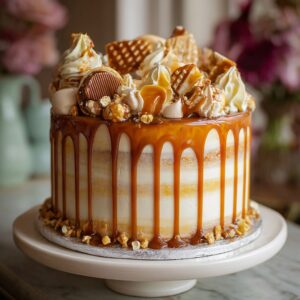
Salted Caramel Drip Cake
Salted Caramel Drip Cake is a luxurious dessert that balances rich sweetness with a hint of salt, featuring moist layers, creamy frosting, and a stunning caramel finish. Perfect for special occasions, it’s endlessly customizable and guaranteed to impress both visually and in flavor.
Ingredients
Cake Ingredients
- 400 g unsalted butter softened
- 400 g light brown sugar
- 7 large eggs or 8 medium eggs
- 400 g self-raising flour
- 2 teaspoons baking powder
- 4 tablespoons whole milk optional, for adjusting batter consistency
Salted Caramel Buttercream
- 250 g unsalted butter at room temperature
- 600 g icing sugar
- 175 g Carnation caramel
- A pinch of sea salt
Decoration
- 200 g Carnation caramel for drip and topping
- A pinch of sea salt
- Rolos for garnish
- Sprinkles optional, for added flair
Instructions
- For the Cake:
- Preheat your oven to 180ºC (160ºC fan) and line three 20cm (8-inch) round cake tins with baking parchment. Set them aside.
- In a stand mixer, beat the softened butter and light brown sugar together until pale, fluffy, and well combined.
- Add in the self-raising flour, eggs, and baking powder (if using), and mix briefly until just combined—try not to overmix the batter to keep the cake light.
- Divide the mixture evenly between the prepared tins and smooth the tops. Bake for 25–30 minutes, or until the cakes are golden, spring back when gently pressed, and a skewer inserted into the centre comes out clean.
- Let the cakes cool in their tins for about 10 minutes, then carefully remove them and transfer to a wire rack to cool completely. If the tops have domed slightly, you can cool them upside down to naturally flatten them.
- For the Buttercream:
- In a stand mixer, beat the butter for a few minutes until it’s soft and smooth.
- Gradually add the icing sugar, one-third at a time, beating well between each addition. Once all the sugar is incorporated, continue beating for 5–6 minutes on medium speed until the buttercream is fluffy and light in texture.
- Add the Carnation caramel and a pinch of sea salt, then beat again for 3–4 minutes until smooth and creamy. Taste the buttercream and adjust the salt if needed—add a little more if you want a stronger salted caramel flavor.
- To Assemble and Decorate:
- Once the cake layers are completely cool, place the first layer on a serving plate or cake board. Spread around 2 tablespoons of buttercream over the top, then add the second layer and repeat with another thin layer of buttercream. Place the final sponge on top.
- Using the remaining buttercream, apply a thin crumb coat to the top and sides of the cake using an offset spatula or large scraper. Chill the cake in the fridge for 30 minutes to set.
- Apply a second, slightly thicker layer of buttercream all over the cake and smooth it using a metal scraper. The more buttercream you apply, the easier it is to achieve a smooth finish—but be aware that smoothing will remove some of the excess as you go.
- Chill the cake again for 30 minutes.
- Loosen the remaining Carnation caramel by stirring it gently in a bowl, then transfer it to a piping bag. Pipe drips around the top edge of the cake, allowing the caramel to run slightly over the sides—it doesn’t take much per drip as it naturally runs down. Fill in the top of the cake with caramel and spread it gently to cover. Chill again for another 30 minutes to help set the caramel.
- Finish by piping any remaining buttercream onto the top of the cake, keeping the swirls slightly in from the edge to prevent them from sliding due to the caramel. Decorate with Rolos, sprinkles, and any other toppings you like. Enjoy your show-stopping Salted Caramel Drip Cake